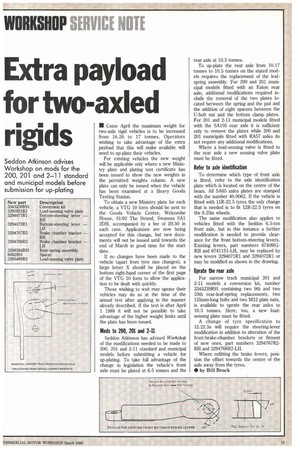Extra payload for two-axled rigids
Page 105

If you've noticed an error in this article please click here to report it so we can fix it.
Seddon Atkinson advises Workshop on mods for the 200, 201 and 2-11 standard and municipal models before submission for up-plating
• Come April the maximum weight for two-axle rigid vehicles is to be increased from 16.26 to 17 tonnes. Operators wishing to take advantage of the extra payload that this will make available will need to up-plate their vehicles.
For existing vehicles the new weight will be applicable only where a new Ministry plate and plating test certificate has been issued to show the new weights in the permitted weights column. A new plate can only be issued when the vehicle has been examined at a Heavy Goods Testing Station.
To obtain a new Ministry plate for each vehicle, a VTG 10 form should be sent to the Goods Vehicle Centre, Welcombe House, 91/92 The Strand, Swansea SA1 2D11, accompanied by a fee of 29.50 in each case. Applications are now being accepted for this change, but new documents will not be issued until towards the end of March in good time for the start date.
If no changes have been made to the vehicle (apart from tyre size changes), a large letter X should be placed on the bottom right-hand corner of the first page of the VTG 10 form to allow the application to be dealt with quickly_ Those wishing to wait may uprate their vehicles may do so at the time of the annual test after applying in the manner already described. If the test is after April 1 1988 it will not be possible to take advantage of the higher weight limits until the plate has been issued.
Mods to 200, 201 and 2-11 Seddon Atkinson has advised Workshop of the modifications needed to be made to 200, 201 and 2-11 standard and municipal models before submitting a vehicle for up-plating. To take full advantage of the change in legislation the vehicle's front axle must be plated at 6.5 tonnes and the
rear axle at 10.5 tonnes.
To up-plate the rear axle from 10.17 tonnes to 10.5 tonnes on the stated models requires the replacement of the leafspring assembly. For 200 and 201 municipal models fitted with an Eaton rear axle, additional modifications required include the removal of the two plates located between the spring and the pad and the addition of eight spacers between the U-bolt nut and the bottom clamp plates. For 201 and 2-11 municipal models fitted with the SA105 rear axle it is sufficient only to remove the plates while 200 and 201 municipals fitted with RA57 axles do not require any additional modifications.
Where a load-sensing valve is fitted to the rear axle a new sensing valve plate must be fitted.
Refer to axle identification
To determine which type of front axle is fitted, refer to the axle identification plate which is located on the centre of the beam. All SA65 axles plates are stamped with the number 40.0062. If the vehicle is fitted with 11R-22.5 tyres the only change that is needed is to fit 12R-22.5 tyres on the 8.25in wheels.
The same modification also applies to vehicles fitted with the Seddon 6.5-ton front axle, but in this instance a further modification is needed to provide clearance for the front bottom-steering levers. Existing levers, part numbers 6740951RH and 67411S1-LH, may be replaced by new levers 3294071R1 and 3294072R1 or may be modified as shown in the drawing.
Uprate the rear axle
For narrow track municipal 201 and 2-11 models a conversion kit, number 3345239R91 containing two 9th and two 10th rear-leaf-spring replacements, two 155mm-long bolts and two M12 plain nuts, is available to uprate the rear axles to 10.5 tonnes. Here, too, a new loadsensing plate must be fitted.
A change of tyre specification to 12.22.5s will require the steering-lever modification in addition to alteration of the front-brake-chamber brackets or fitment of new ones, part numbers 3294767R2RH and 3294768R2-LH.
Where refitting the brake levers, position the offset towards the centre of the axle away from the tyres.
• by Bill Brock
































































































































